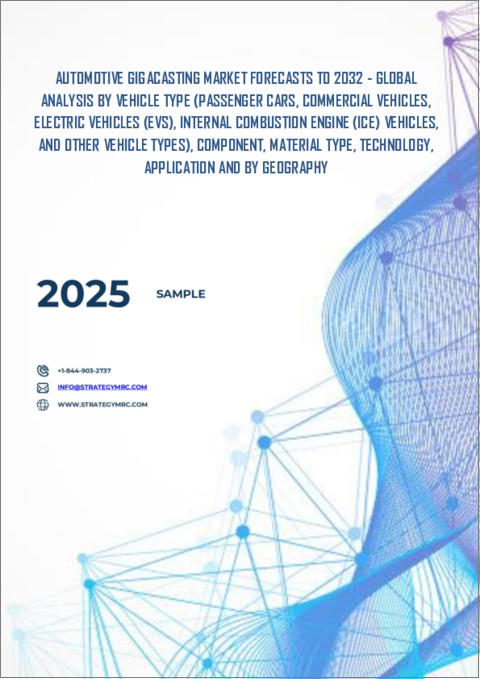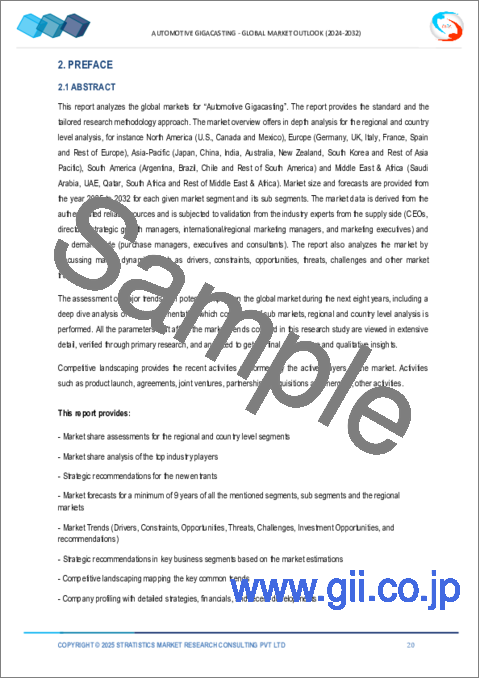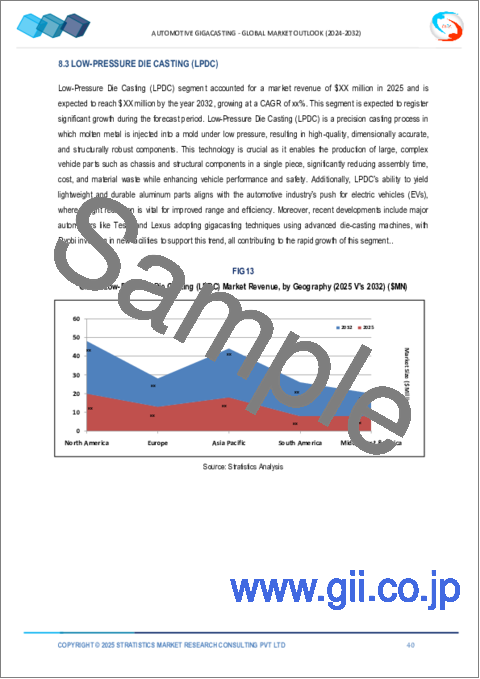|
|
市場調査レポート
商品コード
1716427
自動車用ギガキャスティング市場の2032年までの予測:車両タイプ別、コンポーネント別、材料タイプ別、技術別、用途別、地域別の世界分析Automotive Gigacasting Market Forecasts to 2032 - Global Analysis By Vehicle Type, Component, Material Type, Technology, Application and By Geography |
||||||
カスタマイズ可能
|
|||||||
| 自動車用ギガキャスティング市場の2032年までの予測:車両タイプ別、コンポーネント別、材料タイプ別、技術別、用途別、地域別の世界分析 |
|
出版日: 2025年04月03日
発行: Stratistics Market Research Consulting
ページ情報: 英文 200+ Pages
納期: 2~3営業日
|
全表示
- 概要
- 図表
- 目次
Stratistics MRCによると、自動車用ギガキャスティングの世界市場は2025年に1億5,640万米ドルを占め、予測期間中のCAGRは47.8%で、2032年までには24億981万米ドルに達する見込みです。
自動車用ギガキャスティングは、高圧ダイカスト技術を使って自動車部品を大規模に生産するプロセスです。構造要素や車体部分などの大型部品を一体鋳造します。このプロセスは、自動車の部品点数を大幅に削減し、製造の複雑さとコストを下げます。ギガキャスティングは、より優れた構造的完全性と迅速な組み立てを可能にすると同時に、より軽量で持続可能な車両設計にも貢献します。これは自動車製造における革新であり、現代の自動車の効率と性能を向上させます。
電気自動車に対する需要の高まり
世界各国の政府が持続可能性の促進に取り組むなか、環境意識の高い消費者の間でEVの人気が急速に高まっています。EV部品の生産効率を高めることで、ギガキャスティング技術は価格を下げ、自動車の品質を向上させます。この技術の使用は、スケーラブルな製造と軽量材料への自動車セクターの移行と一致しています。また、EVメーカーに対する優遇措置や補助金などの制度によって成長が加速しています。
大型機械の複雑さ
大型の一体型部品を生産するために設計されたギガキャストマシンは、インフラと熟練労働者への多大な投資を必要とします。このような機械のメンテナンスも課題であり、ダウンタイムは大幅な生産ロスにつながる可能性があります。さらに、既存の生産ラインへのギガキャスティングの統合は、技術的に困難であり、遅延を引き起こす可能性があります。メーカーはまた、機械の耐久性と消費電力に関する懸念に対処する必要があります。ギガキャスティングの普及には、こうした技術的・経済的障壁の克服が不可欠です。
鋳造における技術の進歩
材料科学と3Dプリンティングの革新により、高精度で軽量かつ耐久性の高い自動車部品の生産が可能になりつつあります。こうした進歩により、生産が合理化され、廃棄物が削減され、自動車の性能が向上します。ギガキャスティング技術の使用は、軽量化と効率の最大化が重要な目標である電気自動車にとって特に魅力的です。さらに、自動化とAIを駆使した鋳造技術の開発は、製造工程に革命をもたらすと期待されています。研究開発に投資する企業は、この市場で競争力を獲得する可能性が高いです。
限られた設計の柔軟性
ギガキャスト鋳造機は、大型の単一ピース部品の製造には優れていますが、複雑で入り組んだ設計には苦戦します。自動車メーカーは、多様で進化する設計要件を満たすために、適応性のあるソリューションを必要としています。さらに、ギガキャスティングでは特定の合金や材料に依存するため、新しい設計の実験が制限される可能性があります。こうした制約は、多様な車種へのギガキャスティング技術の採用を妨げる可能性があります。
COVID-19の影響:
COVID-19の大流行は自動車用ギガキャスティング市場にさまざまな影響を与えました。サプライチェーンの混乱と工場閉鎖が当初はギガキャスティングの採用を遅らせましたが、パンデミックはコスト効率と拡張性の高い生産方法の必要性を浮き彫りにしました。パンデミック後は、電気自動車需要の急増がこの技術の採用をさらに加速させています。企業は現在、将来の混乱に対応するため、ギガキャスティングを活用した強靭な製造戦略に注力しています。全体として、パンデミックはギガキャスティングのような革新的製造ソリューションの重要性を浮き彫りにしました。
予測期間中、乗用車セグメントが最大となる見込み
電気自動車に対する消費者の需要の高まりが、軽量で効率的な自動車部品のためのギガキャスティングの採用を促進しているため、乗用車セグメントは予測期間中に最大の市場シェアを占めると予想されます。ギガキャスティングを統合することで、メーカーはより低コストでより精度の高い部品を製造することができます。安全性や耐久性の向上といった特徴は、乗用車メーカーをこの技術にさらに引きつけます。
予測期間中、鉄鋼セグメントのCAGRが最も高くなる見込み
予測期間中、鉄鋼セグメントは最も高い成長率を示すと予測されます。その汎用性、強度、費用対効果により、鉄鋼はギガキャスティングアプリケーションに好まれる材料となっています。EVメーカーは軽量でありながら耐久性のある部品を求めており、スチールの特性はその要求によく合致しています。高度なスチール合金の開発により、自動車用途におけるスチールの魅力はさらに高まっています。さらに、ギガキャスティングは鉄鋼の効率的な利用を可能にし、生産時の材料廃棄を削減します。
最大のシェアを占める地域
予測期間中、アジア太平洋地域が最大の市場シェアを占めると予想されます。同地域の優位性は、活況を呈する自動車産業とEV需要の高まりに起因しています。持続可能性を推進する政府の強力なイニシアチブと先進製造技術への投資が、成長をさらに促進しています。中国、日本、韓国などの国々は、ギガキャスティング革新の最前線にいます。さらに、この地域には大手自動車メーカーやサプライヤーが存在するため、強固なサプライチェーンが確保されています。
CAGRが最も高い地域:
予測期間中、北米地域が最も高いCAGRを示すと予測されます。これは、北米地域の先進的な自動車製造インフラとEV生産への多額の投資が後押ししています。特に米国では、TeslaのようなEVメーカーの間でギガキャスティングの採用が急増しています。さらに、政府の支援政策や鋳造技術研究への資金援助が市場成長を後押ししています。
無料のカスタマイズサービス:
本レポートをご購読のお客様には、以下の無料カスタマイズオプションのいずれかをご利用いただけます:
- 企業プロファイル
- 追加市場企業の包括的プロファイリング(3社まで)
- 主要企業のSWOT分析(3社まで)
- 地域セグメンテーション
- 顧客の関心に応じた主要国の市場推計・予測・CAGR(注:フィージビリティチェックによる)
- 競合ベンチマーキング
- 製品ポートフォリオ、地理的プレゼンス、戦略的提携に基づく主要企業のベンチマーキング
目次
第1章 エグゼクティブサマリー
第2章 序文
- 概要
- ステークホルダー
- 調査範囲
- 調査手法
- データマイニング
- データ分析
- データ検証
- 調査アプローチ
- 調査資料
- 1次調査情報源
- 2次調査情報源
- 前提条件
第3章 市場動向分析
- 促進要因
- 抑制要因
- 機会
- 脅威
- 技術分析
- 用途分析
- 新興市場
- COVID-19の影響
第4章 ポーターのファイブフォース分析
- 供給企業の交渉力
- 買い手の交渉力
- 代替品の脅威
- 新規参入業者の脅威
- 競争企業間の敵対関係
第5章 世界の自動車用ギガキャスティング市場:車両タイプ別
- 乗用車
- 商用車
- 電気自動車(EV)
- 内燃機関(ICE)車
- その他の車両タイプ
第6章 世界の自動車用ギガキャスティング市場:コンポーネント別
- バッテリーエンクロージャ
- シャーシ
- ボディパネル
- サスペンションコンポーネント
- その他のコンポーネント
第7章 世界の自動車用ギガキャスティング市場:材料タイプ別
- マグネシウム
- アルミニウム
- 亜鉛
- 鋼鉄
- その他の材料タイプ
第8章 世界の自動車用ギガキャスティング市場:技術別
- 高圧ダイカスト(HPDC)
- 低圧ダイカスト(LPDC)
- 重力ダイカスト(GDC)
第9章 世界の自動車用ギガキャスティング市場:用途別
- ボディアセンブリ
- エンジン部品
- トランスミッション部品
- その他の用途
第10章 世界の自動車用ギガキャスティング市場:地域別
- 北米
- 米国
- カナダ
- メキシコ
- 欧州
- ドイツ
- 英国
- イタリア
- フランス
- スペイン
- その他欧州
- アジア太平洋
- 日本
- 中国
- インド
- オーストラリア
- ニュージーランド
- 韓国
- その他アジア太平洋
- 南米
- アルゼンチン
- ブラジル
- チリ
- その他南米
- 中東・アフリカ
- サウジアラビア
- アラブ首長国連邦
- カタール
- 南アフリカ
- その他中東・アフリカ
第11章 主要な発展
- 契約、パートナーシップ、コラボレーション、ジョイントベンチャー
- 買収と合併
- 新製品発売
- 事業拡大
- その他の主要戦略
第12章 企業プロファイリング
- Idra S.r.l.
- L.K. Technology Holdings Limited
- Buhler AG
- Haitian Die Casting
- Handtmann Holding GmbH & Co. KG
- Birch Machinery Company Ltd.
- Colosio Srl
- UBE Machinery Inc.
- Yizumi Holdings Co., Ltd.
- Oskar Frech GmbH+Co. KG
- Guangdong Hongtu Technology(Holdings)Co. Ltd.
- Tesla, Inc.
- Volvo Cars
- Toyota Motor Corporation
- Hyundai Motor Company
List of Tables
- Table 1 Global Automotive Gigacasting Market Outlook, By Region (2024-2032) ($MN)
- Table 2 Global Automotive Gigacasting Market Outlook, By Vehicle Type (2024-2032) ($MN)
- Table 3 Global Automotive Gigacasting Market Outlook, By Passenger Cars (2024-2032) ($MN)
- Table 4 Global Automotive Gigacasting Market Outlook, By Commercial Vehicles (2024-2032) ($MN)
- Table 5 Global Automotive Gigacasting Market Outlook, By Electric Vehicles (EVs) (2024-2032) ($MN)
- Table 6 Global Automotive Gigacasting Market Outlook, By Internal Combustion Engine (ICE) Vehicles (2024-2032) ($MN)
- Table 7 Global Automotive Gigacasting Market Outlook, By Other Vehicle Types (2024-2032) ($MN)
- Table 8 Global Automotive Gigacasting Market Outlook, By Component (2024-2032) ($MN)
- Table 9 Global Automotive Gigacasting Market Outlook, By Battery Enclosures (2024-2032) ($MN)
- Table 10 Global Automotive Gigacasting Market Outlook, By Chassis (2024-2032) ($MN)
- Table 11 Global Automotive Gigacasting Market Outlook, By Body Panels (2024-2032) ($MN)
- Table 12 Global Automotive Gigacasting Market Outlook, By Suspension Components (2024-2032) ($MN)
- Table 13 Global Automotive Gigacasting Market Outlook, By Other Components (2024-2032) ($MN)
- Table 14 Global Automotive Gigacasting Market Outlook, By Material Type (2024-2032) ($MN)
- Table 15 Global Automotive Gigacasting Market Outlook, By Magnesium (2024-2032) ($MN)
- Table 16 Global Automotive Gigacasting Market Outlook, By Aluminum (2024-2032) ($MN)
- Table 17 Global Automotive Gigacasting Market Outlook, By Zinc (2024-2032) ($MN)
- Table 18 Global Automotive Gigacasting Market Outlook, By Steel (2024-2032) ($MN)
- Table 19 Global Automotive Gigacasting Market Outlook, By Other Material Types (2024-2032) ($MN)
- Table 20 Global Automotive Gigacasting Market Outlook, By Technology (2024-2032) ($MN)
- Table 21 Global Automotive Gigacasting Market Outlook, By High-Pressure Die Casting (HPDC) (2024-2032) ($MN)
- Table 22 Global Automotive Gigacasting Market Outlook, By Low-Pressure Die Casting (LPDC) (2024-2032) ($MN)
- Table 23 Global Automotive Gigacasting Market Outlook, By Gravity Die Casting (GDC) (2024-2032) ($MN)
- Table 24 Global Automotive Gigacasting Market Outlook, By Application (2024-2032) ($MN)
- Table 25 Global Automotive Gigacasting Market Outlook, By Body Assemblies (2024-2032) ($MN)
- Table 26 Global Automotive Gigacasting Market Outlook, By Engine Parts (2024-2032) ($MN)
- Table 27 Global Automotive Gigacasting Market Outlook, By Transmission Parts (2024-2032) ($MN)
- Table 28 Global Automotive Gigacasting Market Outlook, By Other Applications (2024-2032) ($MN)
Note: Tables for North America, Europe, APAC, South America, and Middle East & Africa Regions are also represented in the same manner as above.
According to Stratistics MRC, the Global Automotive Gigacasting Market is accounted for $156.40 million in 2025 and is expected to reach $2409.81 million by 2032 growing at a CAGR of 47.8% during the forecast period. Automotive gigacasting is the process of using high-pressure die-casting technology to produce vehicle parts on a huge scale. It entails casting large items, including structural elements or automobile body sections, in a single piece. This process significantly reduces the number of parts in a vehicle, lowering manufacturing complexity and costs. Gigacasting enables better structural integrity and faster assembly, while also contributing to lighter, more sustainable vehicle designs. It is an innovation in automotive manufacturing, enhancing efficiency and performance in modern cars.
Market Dynamics:
Driver:
Rising Demand for Electric Vehicles
EVs are quickly becoming more and more popular among environmentally aware consumers as governments around the world work to promote sustainability. By increasing the production efficiency of EV components, gigacasting technology lowers prices and raises vehicle quality. The use of this technology is consistent with the automobile sector's transition to scalable manufacturing and lightweight materials. Growth is also being accelerated by programs like incentives and subsidies for EV manufacturers.
Restraint:
Complexity of large-scale machines
Gigacasting machines, designed to produce large, single-piece components, require significant investment in infrastructure and skilled labor. Maintenance of such machines is another challenge, as downtime can lead to substantial production losses. Additionally, the integration of gigacasting with existing production lines can be technically demanding, causing delays. Manufacturers must also address concerns related to machine durability and power consumption. Overcoming these technical and financial barriers is crucial for the widespread adoption of gigacasting.
Opportunity:
Technological advancements in casting
Innovations in material science and 3D printing are enabling the production of highly precise, lightweight, and durable automotive components. These advancements streamline production, reduce waste, and enhance vehicle performance. The use of gigacasting technology is particularly attractive for electric vehicles, where reducing weight and maximizing efficiency are key goals. Furthermore, developments in automation and AI-driven casting techniques promise to revolutionize the manufacturing process. Companies investing in research and development will likely gain a competitive edge in this market.
Threat:
Limited design flexibility
Gigacasting machines excel at producing large, single-piece components but struggle with complex, intricate designs. Automotive manufacturers require adaptable solutions to meet diverse and evolving design requirements. Additionally, the reliance on specific alloys and materials for gigacasting can limit experimentation with new designs. These constraints may hinder the adoption of gigacasting technology across diverse vehicle models.
Covid-19 Impact:
The COVID-19 pandemic had a mixed impact on the Automotive Gigacasting Market. While supply chain disruptions and factory closures initially slowed the adoption of gigacasting, the pandemic highlighted the need for cost-efficient and scalable production methods. Post-pandemic, the surge in electric vehicle demand has further accelerated the adoption of this technology. Companies are now focusing on resilient manufacturing strategies, leveraging gigacasting to meet future disruptions. Overall, the pandemic underscored the importance of innovative manufacturing solutions like gigacasting.
The passenger cars segment is expected to be the largest during the forecast period
The passenger cars segment is expected to account for the largest market share during the forecast period, owing to growing consumer demand for electric vehicles is driving the adoption of gigacasting for lightweight and efficient car components. By integrating gigacasting, manufacturers can produce parts at a lower cost and with greater precision. Features like enhanced safety and durability further attract passenger car manufacturers to this technology.
The steel segment is expected to have the highest CAGR during the forecast period
Over the forecast period, the steel segment is predicted to witness the highest growth rate, due to its versatility, strength, and cost-effectiveness make it a preferred material for gigacasting applications. As EV manufacturers seek lightweight yet durable components, steel's properties align well with their requirements. The development of advanced steel alloys further enhances its appeal for automotive applications. Additionally, gigacasting enables efficient utilization of steel, reducing material waste during production.
Region with largest share:
During the forecast period, the Asia Pacific region is expected to hold the largest market share, driven by the region's dominance can be attributed to its booming automotive industry and the rising demand for EVs. Strong government initiatives promoting sustainability and investments in advanced manufacturing technologies are further driving growth. Countries like China, Japan, and South Korea are at the forefront of gigacasting innovation. Additionally, the presence of leading automotive manufacturers and suppliers in the region ensures a robust supply chain.
Region with highest CAGR:
Over the forecast period, the North America region is anticipated to exhibit the highest CAGR, fuelled by the region's advanced automotive manufacturing infrastructure and significant investments in EV production. The United States, in particular, is seeing an upsurge in gigacasting adoption among EV manufacturers like Tesla. Furthermore, supportive government policies and funding for research in casting technologies bolster market growth.
Key players in the market
Some of the key players in Automotive Gigacasting Market include Idra S.r.l., L.K. Technology Holdings Limited, Buhler AG, Haitian Die Casting, Handtmann Holding GmbH & Co. KG, Birch Machinery Company Ltd., Colosio Srl, UBE Machinery Inc., Yizumi Holdings Co., Ltd., Oskar Frech GmbH + Co. KG, Guangdong Hongtu Technology (Holdings) Co. Ltd., Tesla, Inc., Volvo Cars, Toyota Motor Corporation, and Hyundai Motor Company.
Key Developments:
In September 2024, AV Birch and Triweco announce exciting partnership, AV Birch has proudly been at the forefront of the manufacturing and engineering industry for forty years, leading the way in terms of design and innovation.
In February 2024, Handtmann Group of Companies is pleased to announce the successful closing of the acquisition of Kegelmann Technik GmbH and Kegelmann Tooling GmbH & Co. KG, based in Rodgau-Jugesheim in southern Hesse. Kegelmann counts among the pioneers in plastics engineering with genuine expertise in additive manufacturing and the prototyping of injection moulding tools as well as small and special series production.
Vehicle Types Covered:
- Passenger Cars
- Commercial Vehicles
- Electric Vehicles (EVs)
- Internal Combustion Engine (ICE) Vehicles
- Other Vehicle Types
Component Covered:
- Battery Enclosures
- Chassis
- Body Panels
- Suspension Components
- Other Components
Material Types Covered:
- Magnesium
- Aluminum
- Zinc
- Steel
- Other Material Types
Technologies Covered:
- High-Pressure Die Casting (HPDC)
- Low-Pressure Die Casting (LPDC)
- Gravity Die Casting (GDC)
Applications Covered:
- Body Assemblies
- Engine Parts
- Transmission Parts
- Other Applications
Regions Covered:
- North America
- US
- Canada
- Mexico
- Europe
- Germany
- UK
- Italy
- France
- Spain
- Rest of Europe
- Asia Pacific
- Japan
- China
- India
- Australia
- New Zealand
- South Korea
- Rest of Asia Pacific
- South America
- Argentina
- Brazil
- Chile
- Rest of South America
- Middle East & Africa
- Saudi Arabia
- UAE
- Qatar
- South Africa
- Rest of Middle East & Africa
What our report offers:
- Market share assessments for the regional and country-level segments
- Strategic recommendations for the new entrants
- Covers Market data for the years 2024, 2025, 2026, 2028, and 2032
- Market Trends (Drivers, Constraints, Opportunities, Threats, Challenges, Investment Opportunities, and recommendations)
- Strategic recommendations in key business segments based on the market estimations
- Competitive landscaping mapping the key common trends
- Company profiling with detailed strategies, financials, and recent developments
- Supply chain trends mapping the latest technological advancements
Free Customization Offerings:
All the customers of this report will be entitled to receive one of the following free customization options:
- Company Profiling
- Comprehensive profiling of additional market players (up to 3)
- SWOT Analysis of key players (up to 3)
- Regional Segmentation
- Market estimations, Forecasts and CAGR of any prominent country as per the client's interest (Note: Depends on feasibility check)
- Competitive Benchmarking
- Benchmarking of key players based on product portfolio, geographical presence, and strategic alliances
Table of Contents
1 Executive Summary
2 Preface
- 2.1 Abstract
- 2.2 Stake Holders
- 2.3 Research Scope
- 2.4 Research Methodology
- 2.4.1 Data Mining
- 2.4.2 Data Analysis
- 2.4.3 Data Validation
- 2.4.4 Research Approach
- 2.5 Research Sources
- 2.5.1 Primary Research Sources
- 2.5.2 Secondary Research Sources
- 2.5.3 Assumptions
3 Market Trend Analysis
- 3.1 Introduction
- 3.2 Drivers
- 3.3 Restraints
- 3.4 Opportunities
- 3.5 Threats
- 3.6 Technology Analysis
- 3.7 Application Analysis
- 3.8 Emerging Markets
- 3.9 Impact of Covid-19
4 Porters Five Force Analysis
- 4.1 Bargaining power of suppliers
- 4.2 Bargaining power of buyers
- 4.3 Threat of substitutes
- 4.4 Threat of new entrants
- 4.5 Competitive rivalry
5 Global Automotive Gigacasting Market, By Vehicle Type
- 5.1 Introduction
- 5.2 Passenger Cars
- 5.3 Commercial Vehicles
- 5.4 Electric Vehicles (EVs)
- 5.5 Internal Combustion Engine (ICE) Vehicles
- 5.6 Other Vehicle Types
6 Global Automotive Gigacasting Market, By Component
- 6.1 Introduction
- 6.2 Battery Enclosures
- 6.3 Chassis
- 6.4 Body Panels
- 6.5 Suspension Components
- 6.6 Other Components
7 Global Automotive Gigacasting Market, By Material Type
- 7.1 Introduction
- 7.2 Magnesium
- 7.3 Aluminum
- 7.4 Zinc
- 7.5 Steel
- 7.6 Other Material Types
8 Global Automotive Gigacasting Market, By Technology
- 8.1 Introduction
- 8.2 High-Pressure Die Casting (HPDC)
- 8.3 Low-Pressure Die Casting (LPDC)
- 8.4 Gravity Die Casting (GDC)
9 Global Automotive Gigacasting Market, By Application
- 9.1 Introduction
- 9.2 Body Assemblies
- 9.3 Engine Parts
- 9.4 Transmission Parts
- 9.5 Other Applications
10 Global Automotive Gigacasting Market, By Geography
- 10.1 Introduction
- 10.2 North America
- 10.2.1 US
- 10.2.2 Canada
- 10.2.3 Mexico
- 10.3 Europe
- 10.3.1 Germany
- 10.3.2 UK
- 10.3.3 Italy
- 10.3.4 France
- 10.3.5 Spain
- 10.3.6 Rest of Europe
- 10.4 Asia Pacific
- 10.4.1 Japan
- 10.4.2 China
- 10.4.3 India
- 10.4.4 Australia
- 10.4.5 New Zealand
- 10.4.6 South Korea
- 10.4.7 Rest of Asia Pacific
- 10.5 South America
- 10.5.1 Argentina
- 10.5.2 Brazil
- 10.5.3 Chile
- 10.5.4 Rest of South America
- 10.6 Middle East & Africa
- 10.6.1 Saudi Arabia
- 10.6.2 UAE
- 10.6.3 Qatar
- 10.6.4 South Africa
- 10.6.5 Rest of Middle East & Africa
11 Key Developments
- 11.1 Agreements, Partnerships, Collaborations and Joint Ventures
- 11.2 Acquisitions & Mergers
- 11.3 New Product Launch
- 11.4 Expansions
- 11.5 Other Key Strategies
12 Company Profiling
- 12.1 Idra S.r.l.
- 12.2 L.K. Technology Holdings Limited
- 12.3 Buhler AG
- 12.4 Haitian Die Casting
- 12.5 Handtmann Holding GmbH & Co. KG
- 12.6 Birch Machinery Company Ltd.
- 12.7 Colosio Srl
- 12.8 UBE Machinery Inc.
- 12.9 Yizumi Holdings Co., Ltd.
- 12.10 Oskar Frech GmbH + Co. KG
- 12.11 Guangdong Hongtu Technology (Holdings) Co. Ltd.
- 12.12 Tesla, Inc.
- 12.13 Volvo Cars
- 12.14 Toyota Motor Corporation
- 12.15 Hyundai Motor Company





